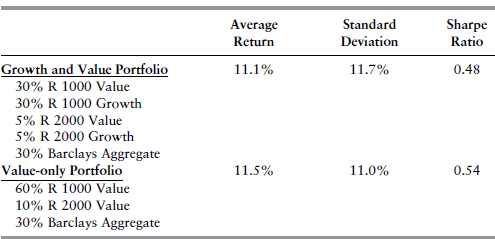PORTFOLIOS WITH GROWTH AND VALUE
Since growth stocks underperform value stocks in the small-cap as well as large-cap spaces, it’s natural to ask the question whether growth stocks belong at all in a portfolio. Or, at the very least, whether growth stocks should be underweighted in a portfolio. To try to answer this question, let’s consider the following experiment. Build a portfolio of stocks and bonds with and without growth stocks and evaluate the difference in performance.
TABLE 4.10 Portfolios with and without Growth Stocks, 1979–2009
Data Source: Barclays Aggregate and Russell®.

Table 4.10 reports on this experiment. There are two portfolios described in the table with 30 percent invested in bonds (in the Barclays Aggregate index) and 70 percent in stocks. In the top of the table is a portfolio with an equal allocation to the Russell 1000 Growth and Value indexes (30 percent each) and with an equal allocation to the Russell 2000 Growth and Value indexes (5 percent each).7 In the bottom of the table is a portfolio where all of the large-cap allocation is given to the Russell 1000 Value index and all of the small-cap allocation is given to the Russell 2000 Value index. The results are interesting. The return on the value-only portfolio is 0.4 percent higher, while the standard deviation is 0.7 percent lower. As a result, the Sharpe ratio is 0.54 for the value-only portfolio compared ...
Get Portfolio Design: A Modern Approach to Asset Allocation now with the O’Reilly learning platform.
O’Reilly members experience books, live events, courses curated by job role, and more from O’Reilly and nearly 200 top publishers.

